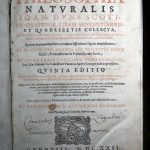In the summer of 2023, Gábriel Szoliva’s research in Varaždin (Croatia) uncovered a notated codex leaf, which is the fifth of a recently identified family of plainchant fragments, presumably of Zagreb origin. The leaves or part of leaves once belonged to a 15th–16th century antiphoner, apparently cut from the corpus for bookbinding purposes. Based on the music palaeographical and liturgical content of the fragments, the former mother codex was previously identified as being of Zagreb origin (see descriptions of F 1105 and F 1106). Whether it is a diocesan manuscript or whether the codex was used in the Cathedral of Zagreb itself, remains open.
The Zagreb provenance is confirmed by the fact that the other fragments in the group are currently stored in Zagreb collections: two of them (F 1105, F 1106) in the library of the Franciscan convent, the third in the rare book collection of the city library (F 1113) and the last in the library of the Archbishop’s seminary (F 1118). The Varaždin fragment appeared to be an exception, but the missing link in the chain of the history of the book and the fragment was quickly discovered at several levels. First and foremost, a flip through the host volume provided information. The carrier is the work of Philippus Faber/Fabri, an Italian Franciscan theologian and philosopher (a Franciscan provincial from 1625) active in the early 17th century, who wrote a commentary on Duns Scotus’s Philosophia. The interest in this book, written in Parma and later revised in Venice, is shown by the fact that Faber, a professor from Padua, had his work published several times, presumably for educational purposes. The Varaždin volume, the fifth edition of 1622, was published in Paris in addition to Venice in the same year.
While the Franciscan author and his work as well as the Franciscan repository are intertwined, it is the title page of the print that really lifts the veil on the fate of the book within the Franciscan institutional network in Croatia. The black ink inscription Conventus Zagrabiensis Franciscanorum makes it clear that the volume was formerly owned by the library of the Franciscans in Zagreb, the same library that preserves two other fragments of the antiphoner transmitted on other volumes. It is therefore undisputed that the volume was transferred from Zagreb to Varaždin, although the date remains unclear. There was a lively exchange of books between the three main houses of the Franciscan order named after St. Ladislaus: Zagreb, Varaždin and Pécs, where the seminary education moved to. The book carrying our fragment may have been moved to his new place as part of this traffic.
(See the news archives of the Hungarian Franciscan Library and Archives website about the newly found antiques: https://archivum.ferencesek.hu/index.php?modul=dokumentumok&ut=05%20H%EDrek%20-%20Kiadv%E1nyok%2F05%20H%EDreink&behiv=01%20Megker%FClt%20antikv%E1k%20%28m%E1j_%2031_%29.htm)
As was assumed for the two prints bound in antiphoner fragments in the Franciscan library in Zagreb, the present leaf may have been also bound in a bookbinding workshop in Zagreb, probably at the same time as F 1105 and 1106. This also means that the book may have been delivered to Varaždin already with his cover. We also know that the hair side of the parchment is the verso.
The second surprise came by identifying the office chants preserved on the leaf: as in the Zagreb fragments, transmitted are chants from the office of St. Mary Magdalene – the very end of Matins and the beginning of Lauds. It is this content that makes the binding process reconstructible. It is probable that in the order of cutting out the leaves from the original codex, volumes A-V-179, then A-V-180 were bound, followed by the covering of A-8-169.
The examining the transmitted chants proved also instructive. The lengthy antiphon Rogabat Iesum quidam (https://cantusindex.org/id/204310), which opens the Lauds of the Mary Magdalene office, is a piece with a wide range of regional variations widespread in Central Europe. In medieval Hungary, it is used in the Lauds of the feast in the more peripheral liturgical traditions, e.g. in the northern region of Szepes (Spiš in present-day Slovakia) and around Zagreb, but only the latter’s sources presribe is consistently. In the central Esztergom office tradition the chant appears as the first antiphon of the Matins (see Andrea Kovács, Corpus Antiphonalium Officii Ecclesiarum Centralis Europae V/B Esztergom (Strigonium), Budapest, Institute for Musicology, 2006, 114, 225; Andrea Kovács ed., Corpus Antiphonalium Officii Ecclesiarum Centralis Europae VI/B Kalocsa-Zagreb, Budapest, Institute for Musicology, 2008, 87). The liturgical attribution of the chant seems to be unique to the Zagreb custom. Also pointing towards Zagreb is the last responsory of Matins Armilla Dominus maxillam. The combination of the two phenomena proves beyond doubt the Zagreb origin of the mother codex.
Gabriella Gilányi



